-
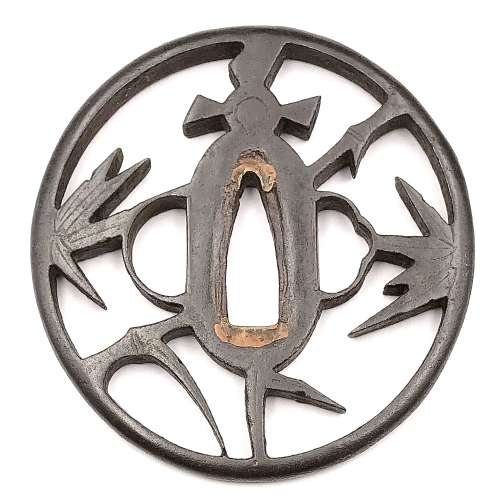 Iron tsuba with design of bamboo and sparrow (take-ni-suzume) in openwork (sukashi). Rounded rim. Copper sekigane. Akasaka school. Unsigned. Attributed to second generation Tadamasa Shōzaemon (died in in the fifth year of Enppo, 1677). Early Edo period: 17th century (Kan-ei / Kanbun era). Height: 79.0 mm. Width: 77.5 mm. Rim thickness: 5.5 mm. Center thickness: 6.6 mm. Provenance: Sasano Masayuki Collection, № 222: "It is believed that sparrows nest in a bamboo grove". According to Merrily Baird [Merrily Baird. Symbols of Japan. Thematic motifs in art and design. Rizzoli international publications, Inc., 2001], "a bamboo grove is said to be emblematic of security as the bamboo is resilient even in the face of high winds and heavy rains. [...] The association of the sparrow (suzume) with bamboo is an old one found in Japanese poetry, paining, and design. The bird is said to be obsessed with its honor, especially the repaying of debts".
Iron tsuba with design of bamboo and sparrow (take-ni-suzume) in openwork (sukashi). Rounded rim. Copper sekigane. Akasaka school. Unsigned. Attributed to second generation Tadamasa Shōzaemon (died in in the fifth year of Enppo, 1677). Early Edo period: 17th century (Kan-ei / Kanbun era). Height: 79.0 mm. Width: 77.5 mm. Rim thickness: 5.5 mm. Center thickness: 6.6 mm. Provenance: Sasano Masayuki Collection, № 222: "It is believed that sparrows nest in a bamboo grove". According to Merrily Baird [Merrily Baird. Symbols of Japan. Thematic motifs in art and design. Rizzoli international publications, Inc., 2001], "a bamboo grove is said to be emblematic of security as the bamboo is resilient even in the face of high winds and heavy rains. [...] The association of the sparrow (suzume) with bamboo is an old one found in Japanese poetry, paining, and design. The bird is said to be obsessed with its honor, especially the repaying of debts". -
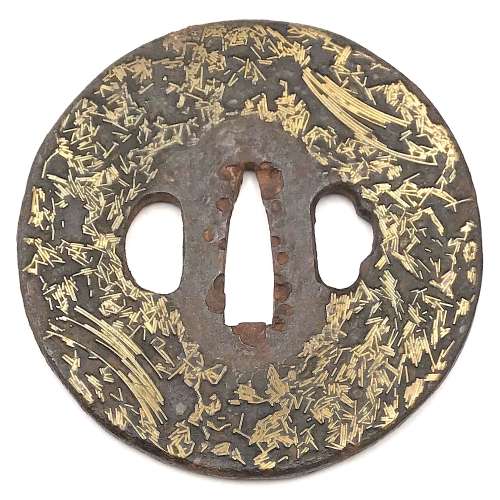 Gomoku-zōgan tsuba. Iron, inlaid with brass scrap (gomoku-zōgan), and polished. Height: 75.3 mm; Width 74.9 mm; Thickness at seppa-dai: 3.6 mm. Weight 130.2 g. Edo, 18th century. Gary D. Murtha dedicates 10 pages to this type of tsuba: "...they were made by soldering brass overlay scraps to the iron plate". Actual gomoku-zōgan tsuba are seldom found in collections most likely because they have little if any artistic attributes. In addition, many have rough surfaces making them questionable for use on a sword. It is said that many of these were produced in Yokohama for export to the West during the late Edo period". G. D. Murtha then describes the technique of making gomoku-zōgan in every detail, and states that "The brass pieces are said to represent 'fallen pine needles', a description most likely created to add aesthetic value to help market the tsuba" [see:Gary D. Murtha. Japanese sword guards. Onin - Heianjo - Yoshiro. GDM Publications, 2016; pp. 160-161].
Gomoku-zōgan tsuba. Iron, inlaid with brass scrap (gomoku-zōgan), and polished. Height: 75.3 mm; Width 74.9 mm; Thickness at seppa-dai: 3.6 mm. Weight 130.2 g. Edo, 18th century. Gary D. Murtha dedicates 10 pages to this type of tsuba: "...they were made by soldering brass overlay scraps to the iron plate". Actual gomoku-zōgan tsuba are seldom found in collections most likely because they have little if any artistic attributes. In addition, many have rough surfaces making them questionable for use on a sword. It is said that many of these were produced in Yokohama for export to the West during the late Edo period". G. D. Murtha then describes the technique of making gomoku-zōgan in every detail, and states that "The brass pieces are said to represent 'fallen pine needles', a description most likely created to add aesthetic value to help market the tsuba" [see:Gary D. Murtha. Japanese sword guards. Onin - Heianjo - Yoshiro. GDM Publications, 2016; pp. 160-161]. -
 Artist: Utagawa Toyokuni I (1769–1825) Actor Matsumoto Kōshirō V plays the role of Ikyû in the drama "Sukeroku Yukari no Edo Zakura". The roles of Sukeroku and the courtesan Agemaki are played by Ichikawa Danjûrô VII and Iwai Hanshirô V". Ichimura Theater in Edo in 2nd lunar month of 1811. Publisher: Chōjiya Kichi (1811-1826); Marks' "Publishers" № 028, p. 103. Size: Vertical ôban Woodblock print (nishiki-e); ink and color on paper. Signed: Toyokuni ga My print is the right sheet of a triptych (see: Rare books exhibition in January 2013).
Artist: Utagawa Toyokuni I (1769–1825) Actor Matsumoto Kōshirō V plays the role of Ikyû in the drama "Sukeroku Yukari no Edo Zakura". The roles of Sukeroku and the courtesan Agemaki are played by Ichikawa Danjûrô VII and Iwai Hanshirô V". Ichimura Theater in Edo in 2nd lunar month of 1811. Publisher: Chōjiya Kichi (1811-1826); Marks' "Publishers" № 028, p. 103. Size: Vertical ôban Woodblock print (nishiki-e); ink and color on paper. Signed: Toyokuni ga My print is the right sheet of a triptych (see: Rare books exhibition in January 2013). A lookalike triptych by Kunisada can be found in Ronin Gallery:
A lookalike triptych by Kunisada can be found in Ronin Gallery:
 Data from Kabuki21:
Stage names:
Matsumoto Kôshirô V, Ichikawa Komazô III, Ichikawa Sumizô I
Guild: Kôraiya
Line number: GODAIME (V)
Poetry names: Kinshô, Kinkô
Existence: 1764 ~ 10th day of the 5th lunar month of 1838
Connection:
Father: Matsumoto Kôshirô IV
Sons: Matsumoto Kôshirô VI, Ichikawa Sumizô II
Disciples: Matsumoto Kojirô, Matsumoto Kingo I, Matsumoto Hidejûrô II
Data from Kabuki21:
Stage names:
Matsumoto Kôshirô V, Ichikawa Komazô III, Ichikawa Sumizô I
Guild: Kôraiya
Line number: GODAIME (V)
Poetry names: Kinshô, Kinkô
Existence: 1764 ~ 10th day of the 5th lunar month of 1838
Connection:
Father: Matsumoto Kôshirô IV
Sons: Matsumoto Kôshirô VI, Ichikawa Sumizô II
Disciples: Matsumoto Kojirô, Matsumoto Kingo I, Matsumoto Hidejûrô II
Matsumoto Kôshirô V was one of the Kabuki giants, a senryô yakusha, during the Bunka, Bunsei and Tenpô eras. In his 20's he was a tachiyaku actor excelling in nimaime roles like Soga Jûrô Sukenari in sogamono dramas. He started to perform jitsuaku roles from the 11th lunar month of 1798 and quickly became one of the best actors for villain roles, especially in Tsuruya Nanboku IV's kizewamono. He had a considerable influence on actors like Onoe Kikugorô III or Ichikawa Danjûrô VII. The kata he deviced for some of the most famous roles in Kabuki history, like Gonta ("Sushiya") or Nikki Danjô* ("Meiboku Sendai Hagi") are still used nowadays. "The fifth Kôshirô had a very large nose and his eyes were close together, two facial defects the print artists were fond of depicting, so that this Edo actor is easily picked out in the pictures illustrating the theatre of this time." (Zoë Kincaid in "Kabuki, the Popular Stage of Japan")
-

Bronze tsuba of mokkō form with narrow slightly raised rim carved in kebori with the sea weed and inlaid with a lobster (ebi) made of copper on the face and two sea shells made of shakudo on the back. Lobster's antennae inlaid in gold, and eyes inlaid in shakudo. Ishime-ji treated surface.
Unsigned.
Late Edo period (mid-19th century). Dimensions: 76.3 x 71.1 x 3.7 mm -
 Large and thin iron tsuba of round form (width > height) decorated with the design of a tiger sheltering in bamboo in suemon-zōgan brass inlay. A fragment of tail inlay is missing. Bamboo leaves on the reverse. According to Merrily Baird [Symbols, p. 166], tiger sheltering in bamboo symbolizes "weak giving shelter to the strong". Momoyama period. Unsigned. Dimensions: 90.8 x 91.2 x 3.4 (center), 3.1 (rim) mm. Custom wooden box. NBTHK Certificate № 4001593.
Large and thin iron tsuba of round form (width > height) decorated with the design of a tiger sheltering in bamboo in suemon-zōgan brass inlay. A fragment of tail inlay is missing. Bamboo leaves on the reverse. According to Merrily Baird [Symbols, p. 166], tiger sheltering in bamboo symbolizes "weak giving shelter to the strong". Momoyama period. Unsigned. Dimensions: 90.8 x 91.2 x 3.4 (center), 3.1 (rim) mm. Custom wooden box. NBTHK Certificate № 4001593. -
 Katsukawa Shunshō ( 勝川 春章; 1726 – 19 January 1793).
Katsukawa Shunshō ( 勝川 春章; 1726 – 19 January 1793).Signed: Katsukawa Shunshô ga (勝川春章画).
The size is somewhat larger than the standard pillar print (hashira-e): 16.3 x 67.7 cm.
No references found so far.
-
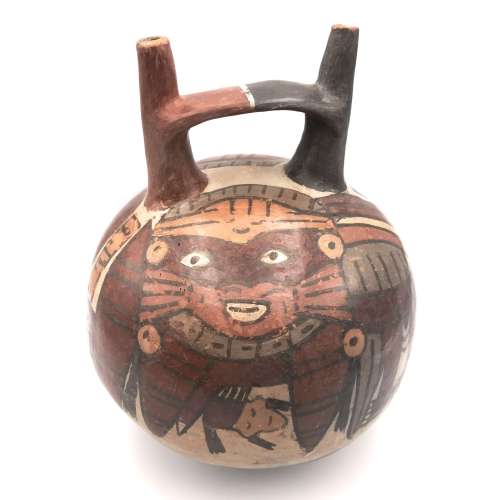
Pre-Columbian, South Coast of Peru, Nazca, ca. 400 - 600 CE. Polychrome double-spout, or stir-up vessel (jar, or bottle), decorated on both sides with designs of masked Mythical Spotted Cat (or the Cat Deity) with a trophy head. Colors: Black, Cream, Gray, Orange, White, Dark Red, Light Red (8 colors).
Size: 17.2 x 14 cm.
References:- A Sourcebook of Nasca Ceramic Iconography: Reading a Culture through Its Art. Donald A. Proulx. University of Iowa Press, 2006; pp. 88-91. [LIB-1556].
- The Archaeology and Pottery of Nazca, Peru: Alfred Kroeber’s 1926 Expedition. Alfred L. Kroeber and Donald Collier, edited by Patrick H. Carmichael with an afterword by Katharina J. Schreiber. AltaMira Press in coop. with Field Museum, Chicago, Il., 1998; p.121. [LIB-1557].
Ex Arte Xibalba, Florida; Ex Robert Dowling Gallery, San Francisco, CA.
-

Small iron tsuba (tantō size) of oval form carved with imitation of six overlapping plates, decorated with paulownia blossoms, leaves, and tendrils in brass and copper hira-zōgan. Copper sekigane. Open kozuka hitsu-ana.
Early Edo period, 17th century.
Size: 50.5 x 34.0 x 4.9 mm.
-
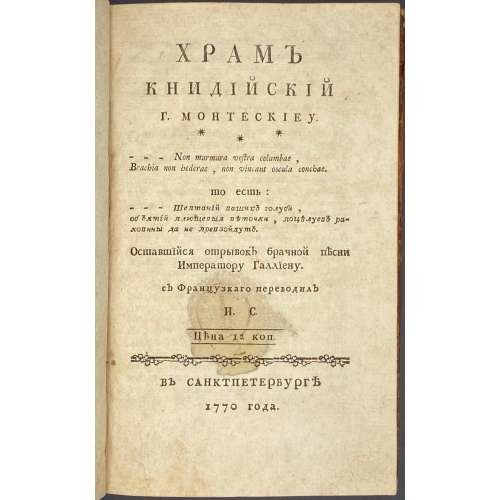 Шарль Монтескье. Храм Книдийский (пер. Иван Сичкарев). Лисимах. Разговор Суллы с Эвкратом. Опыт о вкусе (пер. Семён Башилов). — СПб.: [Тип. Акад. наук], 1770. Pagination: [2 blank] [2 t.p. храм, blank] [4 preface] [1] 2-72, [1, 2 t.p. лисимах, blank] [1] 2-12 [13, 14 t.p. силла] 16-33, [34 blank] [35, 37 t.p. опыт, blank] 38-95 [96 errata] [2 blank]. Size: 12mo, 20 x 12.5 cm, Binding: Contemporary polished brown slightly stained calf, gilt-ruled borders, flat spine with gilt bands and tools in compartments, black title label with gilt lettering to spine, marbled end-papers. Inscriptions and marks: Ink hand-writing to ff: "Люб. Дубенская, Москва XII 1931"; "Ленкнигторг" label glued to the recto of back free leaf; "Антикварная торговля В. И. Клочкова. СПБ., Литейный 55" label pasted to back pastedown. Printed on laid paper with "key" image printed on recto and protruding to the verso to t.p. of Храм Книдийский and Лисимах. Imperial orthography. Engraved head and tailpieces.
Шарль Монтескье. Храм Книдийский (пер. Иван Сичкарев). Лисимах. Разговор Суллы с Эвкратом. Опыт о вкусе (пер. Семён Башилов). — СПб.: [Тип. Акад. наук], 1770. Pagination: [2 blank] [2 t.p. храм, blank] [4 preface] [1] 2-72, [1, 2 t.p. лисимах, blank] [1] 2-12 [13, 14 t.p. силла] 16-33, [34 blank] [35, 37 t.p. опыт, blank] 38-95 [96 errata] [2 blank]. Size: 12mo, 20 x 12.5 cm, Binding: Contemporary polished brown slightly stained calf, gilt-ruled borders, flat spine with gilt bands and tools in compartments, black title label with gilt lettering to spine, marbled end-papers. Inscriptions and marks: Ink hand-writing to ff: "Люб. Дубенская, Москва XII 1931"; "Ленкнигторг" label glued to the recto of back free leaf; "Антикварная торговля В. И. Клочкова. СПБ., Литейный 55" label pasted to back pastedown. Printed on laid paper with "key" image printed on recto and protruding to the verso to t.p. of Храм Книдийский and Лисимах. Imperial orthography. Engraved head and tailpieces. -
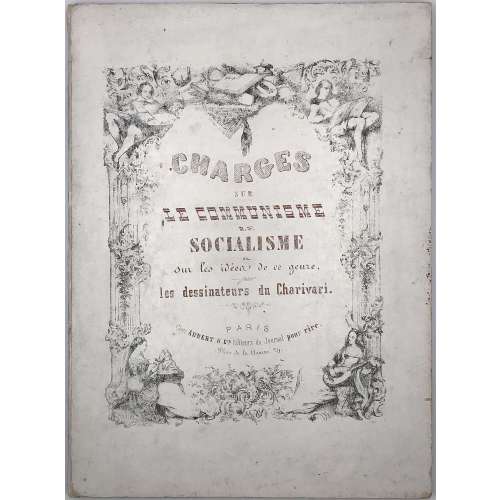 Charges sur le Communisme, le socialisme et sur les idées de ce genre par les dessinateurs du Charivari. Binding: original cardboard. Catalogue raisonée: Hazard & Delteil 1904 / Catalogue raisonné de l'oeuvre lithographié de Honoré Daumier [LIB-2176.2019 in this collection], p. 267: 20 illustrations by Daumier, Cham, Vernier, Ed. de Beaumont. Sticker: Vendu par Francois, Grande-Rue №33, à Rouen. Bought in Paris, seller claimed 1848, first edition. Similar title here : #31. Charges sur le communisme Le socialisme et sur les idées de ce genre par les dessinateurs. Paris, Chez Aubert & Cie., Éditeurs du Journal pour rire, sans date (vers 1865). Relié, plein cartonnage vert décoré et illustré de l'éditeur, in-folio (34,5 x 26 cm) de 20 planches lithographiées. 250 €. Caricatures par Cham (11), Gustave Janet (1), ADC (1), sans nom (3), Daumier (1), Lorentz-Jean-Paul Laurens (3). Nous trouvons pour ce même cartonnage des recueils différents à diverses périodes ; le nôtre doit dater des années 1865-67, moment où Jean-Pierre Laurens fut condamné par la justice du Second Empire pour son anticléricalisme.
Charges sur le Communisme, le socialisme et sur les idées de ce genre par les dessinateurs du Charivari. Binding: original cardboard. Catalogue raisonée: Hazard & Delteil 1904 / Catalogue raisonné de l'oeuvre lithographié de Honoré Daumier [LIB-2176.2019 in this collection], p. 267: 20 illustrations by Daumier, Cham, Vernier, Ed. de Beaumont. Sticker: Vendu par Francois, Grande-Rue №33, à Rouen. Bought in Paris, seller claimed 1848, first edition. Similar title here : #31. Charges sur le communisme Le socialisme et sur les idées de ce genre par les dessinateurs. Paris, Chez Aubert & Cie., Éditeurs du Journal pour rire, sans date (vers 1865). Relié, plein cartonnage vert décoré et illustré de l'éditeur, in-folio (34,5 x 26 cm) de 20 planches lithographiées. 250 €. Caricatures par Cham (11), Gustave Janet (1), ADC (1), sans nom (3), Daumier (1), Lorentz-Jean-Paul Laurens (3). Nous trouvons pour ce même cartonnage des recueils différents à diverses périodes ; le nôtre doit dater des années 1865-67, moment où Jean-Pierre Laurens fut condamné par la justice du Second Empire pour son anticléricalisme. -
![[Voltaire]. La Henriade, nouvelle édition / 2 Vol. — Paris: la Veuve Duchesne, Saillant, Desaint, Panckoucke et Nyon, [1769]-1770.](https://varshavskycollection.com/wp-content/uploads/2021/02/LIB-2581-1.2020-1-4-500x500.jpeg) A two-volume set. Vol. 1: LA | HENRIADE, | NOUVELLE ÉDITION | A PARIS | [medallion portrait of Voltaire] | Chez la Veuve Duchesne, Saillant, Desaint, | Panckoucke et Nyon, Libraires. || Pagination: [2] – engraved title with medallion portrait of Voltaire / blank, [i-iii] iv-xl, [1-3] 4-272, 10 plates and 10 vignettes after Eisen by de Longueil. Collation: 8vo; a-b8 c4, A-R8 Vol. 2: LA | HENRIADE, | NOUVELLE ÉDITION. | — | SECONDE PARTIE. |— | [Floral device] | A PARIS, | Chez la Veuve Duchesne, Saillant, Desaint, | Panckoucke et Nyon, Libraires. | — | M. DCC. LXX. Pagination: [1, 2] - t.p. / imprim., 3-316 [4 - table, imprint "De l'Imprimerie de Barbou."] Collation: A-V8. Binding: full brown calf, raised bands with the gilt floral tools in compartments, red and dark brown labels with gilt lettering: title, author, vol. number, and year; printed on laid paper. Wear, marks and rubbing, endpapers, corners and spine repaired/replaced; leaves are generally clean with the odd mark here or there. With frontispiece, 10 vignettes and 10 plates in vol. 1 as called for. Size: 19 x 12.5 cm each volume. Catalogue raisonné.: G. Ray, p. 59; Cohen-de Ricci p. 1026. LIB-2581-1.2020 and LIB-2581-2.2020.Illustrated by: Charles Eisen (French, 1720 – 1778) Engraved by: Joseph de Longueil (French, 1730 – 1792) Author: François Marie Arouet de Voltaire (French, 1694 – 1778) Publisher: Veuve Duchesne (Nicolas Bonaventure Duchesne died in 1765) Printer: Joseph Gérard Barbou (French, 1723 – 1790)
A two-volume set. Vol. 1: LA | HENRIADE, | NOUVELLE ÉDITION | A PARIS | [medallion portrait of Voltaire] | Chez la Veuve Duchesne, Saillant, Desaint, | Panckoucke et Nyon, Libraires. || Pagination: [2] – engraved title with medallion portrait of Voltaire / blank, [i-iii] iv-xl, [1-3] 4-272, 10 plates and 10 vignettes after Eisen by de Longueil. Collation: 8vo; a-b8 c4, A-R8 Vol. 2: LA | HENRIADE, | NOUVELLE ÉDITION. | — | SECONDE PARTIE. |— | [Floral device] | A PARIS, | Chez la Veuve Duchesne, Saillant, Desaint, | Panckoucke et Nyon, Libraires. | — | M. DCC. LXX. Pagination: [1, 2] - t.p. / imprim., 3-316 [4 - table, imprint "De l'Imprimerie de Barbou."] Collation: A-V8. Binding: full brown calf, raised bands with the gilt floral tools in compartments, red and dark brown labels with gilt lettering: title, author, vol. number, and year; printed on laid paper. Wear, marks and rubbing, endpapers, corners and spine repaired/replaced; leaves are generally clean with the odd mark here or there. With frontispiece, 10 vignettes and 10 plates in vol. 1 as called for. Size: 19 x 12.5 cm each volume. Catalogue raisonné.: G. Ray, p. 59; Cohen-de Ricci p. 1026. LIB-2581-1.2020 and LIB-2581-2.2020.Illustrated by: Charles Eisen (French, 1720 – 1778) Engraved by: Joseph de Longueil (French, 1730 – 1792) Author: François Marie Arouet de Voltaire (French, 1694 – 1778) Publisher: Veuve Duchesne (Nicolas Bonaventure Duchesne died in 1765) Printer: Joseph Gérard Barbou (French, 1723 – 1790) -
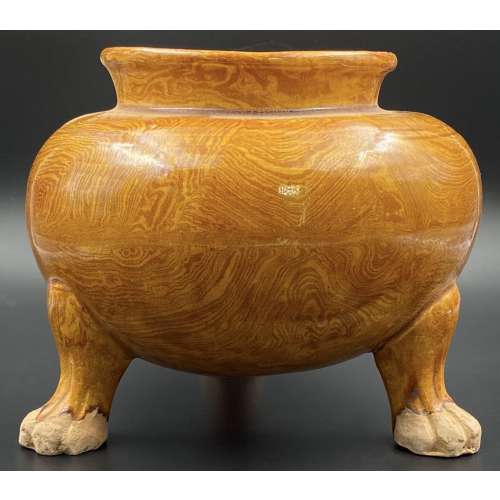 Amber-glazed marbled pottery tripod censer, standing on unglazed beast's paws. The clay itself is not marbled, only the glaze. China, the Tang dynasty [唐朝] (618 – 907). Diameter: 16 cm; Height: 14 cm.
Amber-glazed marbled pottery tripod censer, standing on unglazed beast's paws. The clay itself is not marbled, only the glaze. China, the Tang dynasty [唐朝] (618 – 907). Diameter: 16 cm; Height: 14 cm. -
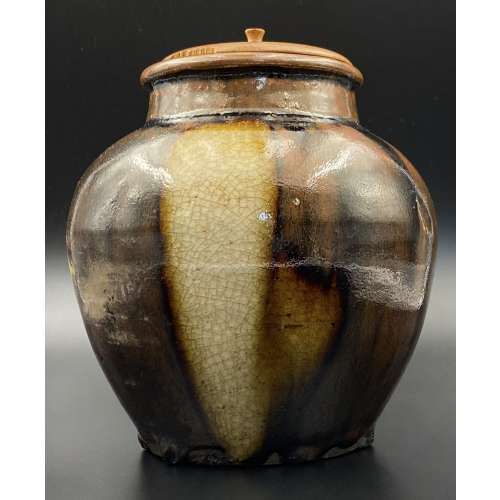 Seller's description: "pottery jar presenting a circular, concave base, an apple-form body, a cylindrical neck, and an annular flared rim. Boasting a lustrous burnish, the gorgeous vessel displays three narrow vertical panels in a hue of cream over mottled shades of chocolate brown and mocha on its body and a caramel-coloured neck and rim. The discoid lid features a lovely natural woodgrain surface incised with three decorative concentric circles around a petite knob-like handle. Note the beautiful globules of glaze that decorate the periphery of the base! This type of vessel is known as Seto ware." Size: Dia: 13 cm, H: 14 cm.
Seller's description: "pottery jar presenting a circular, concave base, an apple-form body, a cylindrical neck, and an annular flared rim. Boasting a lustrous burnish, the gorgeous vessel displays three narrow vertical panels in a hue of cream over mottled shades of chocolate brown and mocha on its body and a caramel-coloured neck and rim. The discoid lid features a lovely natural woodgrain surface incised with three decorative concentric circles around a petite knob-like handle. Note the beautiful globules of glaze that decorate the periphery of the base! This type of vessel is known as Seto ware." Size: Dia: 13 cm, H: 14 cm. -
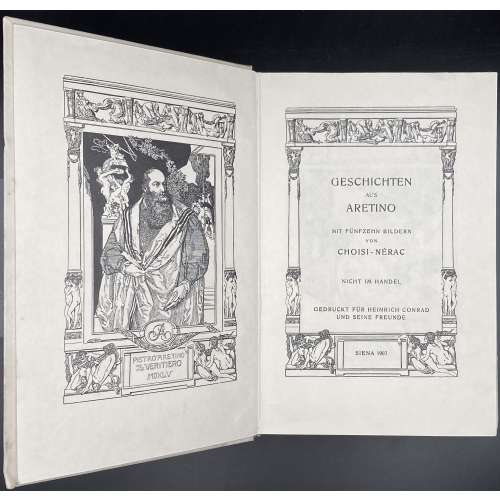 Title: GESCHICHTEN | AUS | ARETINO | MIT FÜNFZEHN BILDERN | VON | CHOISI-NÉRAC | NICHT IM HANDEL | GEDRUCKT FÜR HEINRICH CONRAD | UND SEINE FREUNDE | SIENA 1907 || Collation: 8vo; 1-128 137; frontispiece, t.p. and 14 plates, extraneous to collation. Pagination: [2] f.t. / blank, 3-203 [2], il. Binding: Full cream vellum, ruled with gilt double-fillet, grey label with gilt lettering to spine. Bookplate by von Bayros Par Avi Cigno to front pastedown. Note: Private edition of Aretino's Ragionamenti in German as Geschichten aus Aretino by translater and publisher Heinrich Conrad (German, 1866 – 1918), whose real name was Hugo Storm, this copy №394, illustrated by Franz von Bayros (Austrian, 1866 – of Choisi-Nérac.
Title: GESCHICHTEN | AUS | ARETINO | MIT FÜNFZEHN BILDERN | VON | CHOISI-NÉRAC | NICHT IM HANDEL | GEDRUCKT FÜR HEINRICH CONRAD | UND SEINE FREUNDE | SIENA 1907 || Collation: 8vo; 1-128 137; frontispiece, t.p. and 14 plates, extraneous to collation. Pagination: [2] f.t. / blank, 3-203 [2], il. Binding: Full cream vellum, ruled with gilt double-fillet, grey label with gilt lettering to spine. Bookplate by von Bayros Par Avi Cigno to front pastedown. Note: Private edition of Aretino's Ragionamenti in German as Geschichten aus Aretino by translater and publisher Heinrich Conrad (German, 1866 – 1918), whose real name was Hugo Storm, this copy №394, illustrated by Franz von Bayros (Austrian, 1866 – of Choisi-Nérac. -
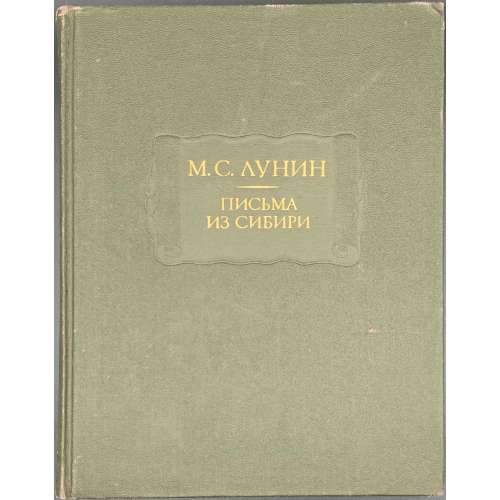 Title (black and red): М. С. ЛУНИН | — | ПИСЬМА ИЗ СИБИРИ | — | Издание подготовили | И. А. Желвакова и Н. Я Эйдельман | МОСКВА | «НАУКА» | 1987 || Pagination: [1, 2] Serial h.t. / blank, [3, 4] t.p. / imprint, [5] 6-492 [4], 1 portrait and 8 leaves of plates. Collation: 16mo; [1]16 216 38 (plates), 4-1716. Binding: serial green buckram blind-stamped with a scroll adorned with gold lettering to board and spine.
Title (black and red): М. С. ЛУНИН | — | ПИСЬМА ИЗ СИБИРИ | — | Издание подготовили | И. А. Желвакова и Н. Я Эйдельман | МОСКВА | «НАУКА» | 1987 || Pagination: [1, 2] Serial h.t. / blank, [3, 4] t.p. / imprint, [5] 6-492 [4], 1 portrait and 8 leaves of plates. Collation: 16mo; [1]16 216 38 (plates), 4-1716. Binding: serial green buckram blind-stamped with a scroll adorned with gold lettering to board and spine. -
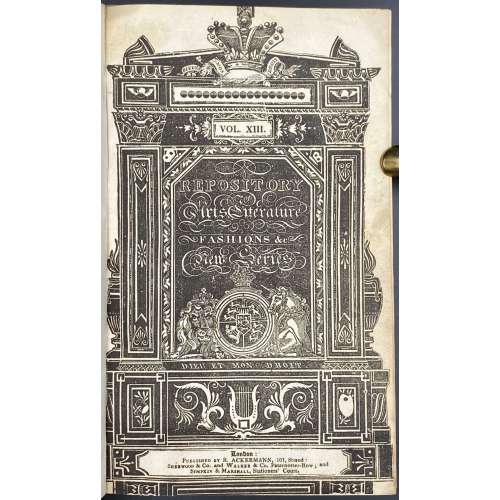 Pagination: [2] – letterpress title / blank, t.p. with contents / to readers, [1] 2-376 + 7 b/w and 16 coloured plates (total 23); this differs to Abbey’s description of 372 pages + 4 pages index, and 41 plates (lacking 18 plates). In No 73 lacking 3 plates: Quadrant Regent st., Morning dress and Full dress. In No 74 lacking 5 plates: Charles str., Brienz, head dresses, full dress, and muslin patterns. In No 75 lacking 5 plates: 4 with bank notes and Castle of Rinkenberg. In No 76 lacking 1 plate: Cavern St. Beat. In No 77 lacking 2 plates: Wetzar and Lake Thun. In No 78 lacking 2 plates: Crescent at Portland Place and Environs of Thun. Collation: 4to; letterpress title, [A]1 B-Z4 Aa-Zz4 3A-3C4 3D2. Binding: 23.5 x 15.5 cm; double fillet blind-ruled half-calf over pebbled cloth boards, raised bands ruled blind, crimson label with gilt lettering to spine. References: Martin Hardie (1906), p.310 [LIB-2623.2021]; R. V. Tooley (1935), p. 26 [LIB-2641.2021]; J. R. Abbey (1953), Cat. № 212, p. 174 [LIB-2622.2021].
Pagination: [2] – letterpress title / blank, t.p. with contents / to readers, [1] 2-376 + 7 b/w and 16 coloured plates (total 23); this differs to Abbey’s description of 372 pages + 4 pages index, and 41 plates (lacking 18 plates). In No 73 lacking 3 plates: Quadrant Regent st., Morning dress and Full dress. In No 74 lacking 5 plates: Charles str., Brienz, head dresses, full dress, and muslin patterns. In No 75 lacking 5 plates: 4 with bank notes and Castle of Rinkenberg. In No 76 lacking 1 plate: Cavern St. Beat. In No 77 lacking 2 plates: Wetzar and Lake Thun. In No 78 lacking 2 plates: Crescent at Portland Place and Environs of Thun. Collation: 4to; letterpress title, [A]1 B-Z4 Aa-Zz4 3A-3C4 3D2. Binding: 23.5 x 15.5 cm; double fillet blind-ruled half-calf over pebbled cloth boards, raised bands ruled blind, crimson label with gilt lettering to spine. References: Martin Hardie (1906), p.310 [LIB-2623.2021]; R. V. Tooley (1935), p. 26 [LIB-2641.2021]; J. R. Abbey (1953), Cat. № 212, p. 174 [LIB-2622.2021]. -
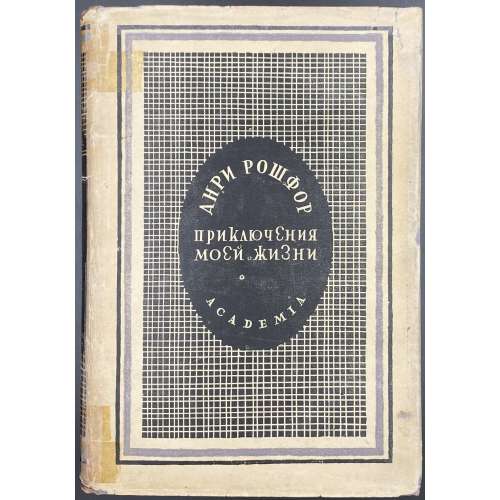 Title (in black and red): АНРИ РОШФОР | ПРИКЛЮЧЕНИЯ МОЕЙ ЖИЗНИ | ПЕРЕВОД, ВСТУПИТЕЛЬНАЯ | СТАТЬЯ И ПРИМЕЧАНИЯ | Е. СМИРНОВА | ACADEMIA | 1933 || Opposite title: ИНОСТРАННЫЕ МЕМУАРЫ, ДНЕВНИКИ, | ПИСЬМА И МАТЕРИАЛЫ | Под редакцией И. Т. Смилги ( whited-out) | АНРИ РОШФОР | 1831—1913 | ACADEMIA | МОСКВА — ЛЕНИНГРАД || Title verso: Henri Rochefort | Les Aventures de ma vie. | Переплет и суперобложка | по рисункам М. В. Ушакова-Поскочина. Pagination: [1, 2] – publisher’s device / blank, [3, 4] – opposite title, [5, 6] – t.p. / orig. title, 7-452 [453-460], ill. Collation: [1]-288 296 + 15 plates extraneous to collation. Binding: burgundy cloth ruled blind and stamped in gilt with a lantern to cover and lettering to spine, pictorial DJ; top margin red. Catalogue raisonné: Крылов, Е. В. Кичатова. "Academia" (2004): p. 237-8. Ушаков [Ушаков-Поскочин], Максим Владимирович (Russian, 1893 – 1943) – died in NKVD labor camp. Смилга, Ивар Тенисович (Latvian-Russian, 1892 – 1937) — shot dead by NKVD firing squad.
Title (in black and red): АНРИ РОШФОР | ПРИКЛЮЧЕНИЯ МОЕЙ ЖИЗНИ | ПЕРЕВОД, ВСТУПИТЕЛЬНАЯ | СТАТЬЯ И ПРИМЕЧАНИЯ | Е. СМИРНОВА | ACADEMIA | 1933 || Opposite title: ИНОСТРАННЫЕ МЕМУАРЫ, ДНЕВНИКИ, | ПИСЬМА И МАТЕРИАЛЫ | Под редакцией И. Т. Смилги ( whited-out) | АНРИ РОШФОР | 1831—1913 | ACADEMIA | МОСКВА — ЛЕНИНГРАД || Title verso: Henri Rochefort | Les Aventures de ma vie. | Переплет и суперобложка | по рисункам М. В. Ушакова-Поскочина. Pagination: [1, 2] – publisher’s device / blank, [3, 4] – opposite title, [5, 6] – t.p. / orig. title, 7-452 [453-460], ill. Collation: [1]-288 296 + 15 plates extraneous to collation. Binding: burgundy cloth ruled blind and stamped in gilt with a lantern to cover and lettering to spine, pictorial DJ; top margin red. Catalogue raisonné: Крылов, Е. В. Кичатова. "Academia" (2004): p. 237-8. Ушаков [Ушаков-Поскочин], Максим Владимирович (Russian, 1893 – 1943) – died in NKVD labor camp. Смилга, Ивар Тенисович (Latvian-Russian, 1892 – 1937) — shot dead by NKVD firing squad. -
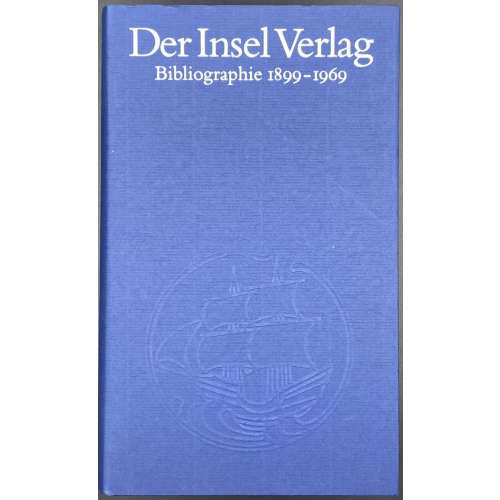 Title: DER INSEL VERLAG | EINE BIBLIOGRAPHIE | 1899-1969 | […] Bearbeitet und herausgegeben | von Heinz Sarkowski | INSEL VERLAG || Pagination: [i-vi] vii-xiii [xiv] [2] 1-452. Binding: Blue cloth, black label with gilt lettering to spine, lettered and blind-stamped DJ.
Title: DER INSEL VERLAG | EINE BIBLIOGRAPHIE | 1899-1969 | […] Bearbeitet und herausgegeben | von Heinz Sarkowski | INSEL VERLAG || Pagination: [i-vi] vii-xiii [xiv] [2] 1-452. Binding: Blue cloth, black label with gilt lettering to spine, lettered and blind-stamped DJ.


